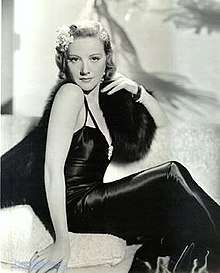Franciska Gaal
Franciska Gaal (born Franciska Silberspitz, 1 February 1903[3] – 2 January 1973) was a Hungarian cabaret artist and film actress of Jewish heritage. Gaal starred in a popular series of European romantic comedies during the 1930s. After attracting interest in Hollywood she moved there and made three films.
Franciska Gaal | |
|---|---|
 Franciska Gaal | |
| Born | 1 February 1903 Budapest, Austro-Hungarian Empire |
| Died | 2 January 1973 (aged 69) New York, New York United States |
| Other names | Szidónia Silberspitz, Fanny Zilverstitch |
| Occupation | Actress |
| Years active | 1921-1946 (film) |
| Spouse(s) | Sándor Lestyán (1922-?)[1] Francis Dajkovich (1934-1965) (his death)[2] |
Early years
Born in Budapest, Gaal was one of 13 children. She studied at the Stage Academy in Budapest in 1919 and by 1920 she appeared in theaters in that city.[4]
Early career
Gall debuted in film in Máté gazda és a törpék (1919).[4]
She was groomed by Joe Pasternak as a singer to become a very popular stage and cabaret performer in Central Europe in the 1920s and 1930s.
She made her first film appearances in some Hungarian silent films of the early 1920s, but her cinema career didn't take off until the arrival of sound.
Hollywood
After appearing in several films made in Hungary, Germany and Austria, two of which were directed by Henry Koster, she came to Hollywood to star in Cecil B. De Mille's epic adventure film, The Buccaneer, opposite Fredric March. She followed this with the comedy The Girl Downstairs (1938) with Franchot Tone, a remake of her Austrian success Catherine the Last. In 1939, Gaal co-starred with Bing Crosby in the musical Paris Honeymoon.[5]
Later life
She returned to Hungary in 1940[5] because of her mother's illness and remained there for the duration of World War II.
In 1946, she began work on a new film in Budapest the Soviet-backed Renee XIV but filming was halted during production and it was never completed. She moved back to the United States in 1947 with her husband Francis de Dajkovich,[3] but her return attracted little interest in Hollywood.[6] In 1950, she made the film Fraulein Lilly in Austria.[5] In 1951, she came to Broadway to replace Eva Gabor in The Happy Time.
Death
Gaal died of thrombosis[4] in New York City.
Filmography
| Year | Title | Role | Notes |
|---|---|---|---|
| 1920 | A bostonville-i kaland | ||
| 1921 | New-York express kábel | Reporter | |
| 1921 | A cornevillei harangok | Serpolette, cselédlány | |
| 1932 | Paprika | Ilona von Takacs | |
| 1933 | Greetings and Kisses, Veronika | Veronika | |
| 1933 | Scandal in Budapest | Eva Balogh | |
| 1934 | A Precocious Girl | Lucie Carell, nicknamed Csibi | |
| 1934 | Spring Parade | Marika | |
| 1934 | Peter | 17-year old Eva | |
| 1935 | Little Mother | Marie Bonnard | |
| 1936 | Catherine the Last | Katharina, Küchenmädchen | |
| 1936 | Fräulein Lilli | Fräulin Lilli | |
| 1938 | The Buccaneer | Gretchen | |
| 1938 | The Girl Downstairs | Katerina Linz | |
| 1939 | Paris Honeymoon | Manya | |
| 1940 | Renee XIV | uncompleted, (final film role) |
References
- http://www.szoloskislak.hu/index.php/gaal-franciska
- https://www.myheritage.com/names/francis_dajkovich
- "May 1947 Passenger list listing her age 44". Ancestry.com.
- Bock, Hans-Michael; Bergfelder, Tim (2009). The Concise Cinegraph: Encyclopaedia of German Cinema. Berghahn Books. p. 144. ISBN 9780857455659. Retrieved 29 August 2018.
- Waldman, Harry; Slide, Anthony (1996). Hollywood and the Foreign Touch: A Dictionary of Foreign Filmmakers and Their Films from America, 1910-1995. Scarecrow Press. pp. 113–114. ISBN 9780810831926. Retrieved 29 August 2018.
- Bock & Bergfelder p.144
Bibliography
- Bock, Hans-Michael & Bergfelder, Tim. The Concise CineGraph. Encyclopedia of German Cinema. Berghahn Books, 2009.